How to use the COT function
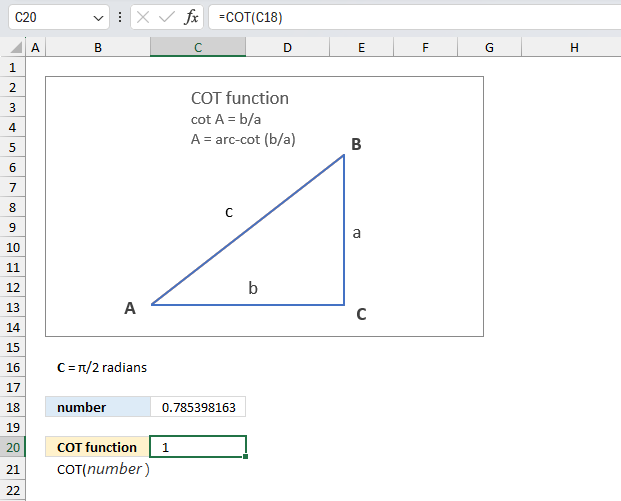
What is the COT function?
The COT function calculates the cotangent of an angle specified in radians.
Table of Contents
1. Introduction
What is the cotangent?
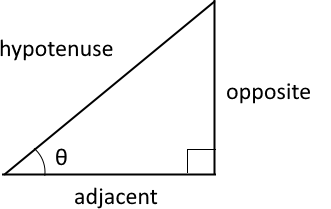
The cotangent is one of the trigonometric functions closely related to the tangent function.
The cot function is defined as the ratio between the the length of adjacent side and length of the opposite side of a right triangle.
cot(θ) = adjacent / opposite
or
defined as the reciprocal of tangent:
cot(θ) = 1 / tan(θ)
The cotangent equals the ratio of the cos and sin:
cot(θ) = cos(θ) / sin(θ)
What is the angle θ?
The Greek letter theta (θ) is commonly used to represent an unknown angle in a right triangle.
What is a right triangle?
A right triangle is a type of triangle that contains one internal angle measuring 90 degrees or π/2 radians (a right angle).
What are radians?
Radians are a unit used to measure angles. An angle of 1 radian has an arc length equal to the circle's radius.
What is the relationship between the number pi and radians?
Radians measure angles by the length of the arc they make in a circle rather than degrees. The full circumference of any circle is 2π multiplied by the circle's radius (2πr).
Since the circumference goes all the way around a circle, that means the full circle measures 2π radians. Half a circle would be π radians (half of 2π). A quarter circle is 2π/4 = π/2 radians. An eighth of a circle is 2π/8 = π/4 radians.
Excel has a function that returns the number pi: PI function
What are the main trigonometric functions, their domain and range?
| Function | Domain (input) | Range (output) |
| sin(x) | All real numbers | (-1, 1) |
| cos(x) | All real numbers | (-1, 1) |
| tan(x) | All real numbers except multiples of π/2 | (-∞, ∞) |
| sec(x) | All real numbers except multiples of π | (1, ∞) U (-∞, -1) |
| csc(x) | All real numbers except integer multiples of π | (-∞, -1) U (1, ∞) |
| cot(x) | All real numbers except integer multiples of π | (-∞, ∞) |
What are the main trigonometric arcfunctions, their domain and range?
| Function | Domain (input) | Range (output) |
| sin-1(x) | [-1, 1] | (-π/2, π/2) |
| cos-1(x) | [-1, 1] | (0, π) |
| tan-1(x) | All real numbers | (-π/2, π/2) |
| sec-1(x) | [-1, 1] | (0, π/2) U (π/2, π) |
| csc-1(x) | [-1, 1] | (-π/2, -0) U (0, π/2) |
| cot-1(x) | All real numbers | (0, π) |
What is the trigonometric domain?
The domain of a trigonometric function refers to the set of input values it is defined and valid for. The secant, cosecant, and cotangent functions have restricted domains due to their asymptotes.
What is the trigonometric range?
The range of a trigonometric function refers to the set of possible output values it returns.
What are asymptotes in terms of the cotangent function?
Asymptotes are vertical lines that the function approaches but never reaches. Cotangent has vertical asymptotes at integer multiples of π.
2. Syntax
COT(number)
| number | Required. An angle in radians. |
Use the RADIANS function to convert degrees to radians.
Recommended articles
What is the RADIANS function? The RADIANS function converts degrees to radians. Table of Contents Introduction Syntax Example 1 Example […]
3. Example 1
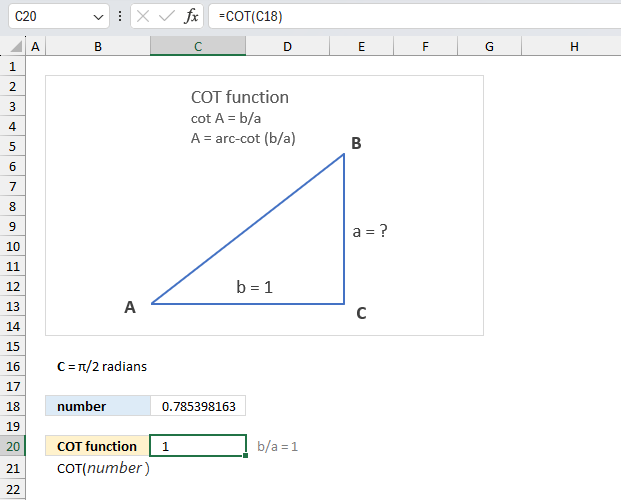
Calculate the cotangent of π/4?
The argument is:
- number: C18 which contains π/4 radians or 0.785398163397448 radians.
Formula in cell C20:
Cell C20 returns the cotangent ratio which in this example is 1.
Determine opposite side (a) if the adjacent side (b) is equal to 1 and the angle (A) is equal to π/4 radians?
Cotangent A = b/a
Cotangent π/4 = 1
1 = b/a
If the ratio 1 is equal to b/a then 1 = 1/a
a = 1/1
a = 1
Determine hypotenuse if the adjacent side (b) is 1 and the opposite side (a) is 1?
You can calculate the hypotenuse using Pythagoras theorem which states that the squared hypotenuse is equal to the sum of the squared opposite side and the adjacent side.
c2 = a2 + b2
b = 1
a = 1
c2 = 12 + 12
c2 = 2
c = √2
c = 1.41421356237309
4. Example 2
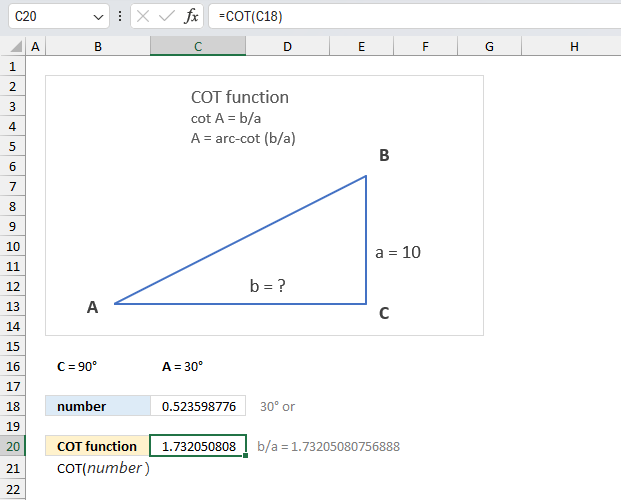
In a right triangle, if one acute angle measures 30 degrees and the opposite is 10 units long, find the length of the side adjacent to that angle?
The argument is:
- number: C18 which represents the angle in radians. Cell C18 contains 0.523598775598299 radians or π/6 radians 30 degrees.
Formula in cell C20:
Cell C20 returns the cotangent ratio which in this example is 1.73205080756888.
The question tells us that the opposite side in the triangle is 10 (a) and the cotangent ratio is 1.73205080756888.
number = adjacent / opposite= b/a = b/10 = 1.73205080756888
b = 10 * 1.73205080756888
b = 17.3205080756888
The length of the adjacent side (b) is 17.3205080756888
5. Example 3
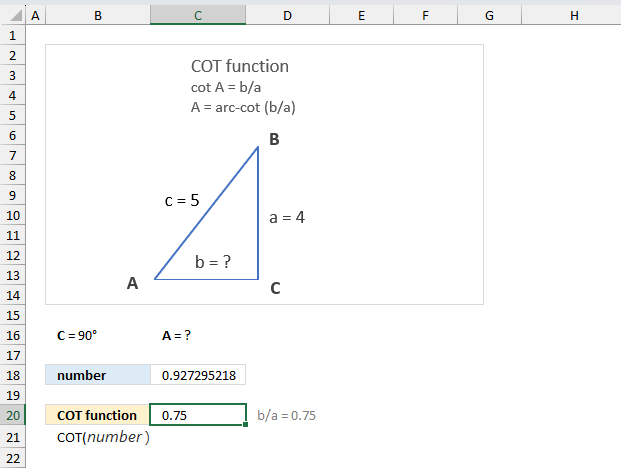
Calculate the cotangent ratio if the hypotenuse is 5 and the opposite side is 4?
The arc-sine (ASIN function) can help us calculate the angle A based on the length of the hypotenuse and opposite side. The arc-sine of 4/5 equals 0.927295218001612 radians.
We now have the argument for the COT function so we can calculate the cotangent ratio.
The argument is:
- number: Cell reference C18 which represents the angle in radians. Cell C18 contains 0.927295218001612 radians.
Formula in cell C20:
Cell C20 returns the cotangent ratio which in this example is 0.75.
b/a = 0.75
b = 4 * 0.75
b = 3
It is also possible to calculate the adjacent side b using the Pythagoras theorem which states that the squared hypotenuse is equal to the sum of the squared opposite side and the adjacent side. c2 = a2 + b2
b = (c2 - a2)(1/2)
b = (52 -42)(1/2)
b = (25 -16)(1/2)
b = (9)(1/2)
b = 3
The cotangent ratio is 3/4 = 0.75
6. Example 4
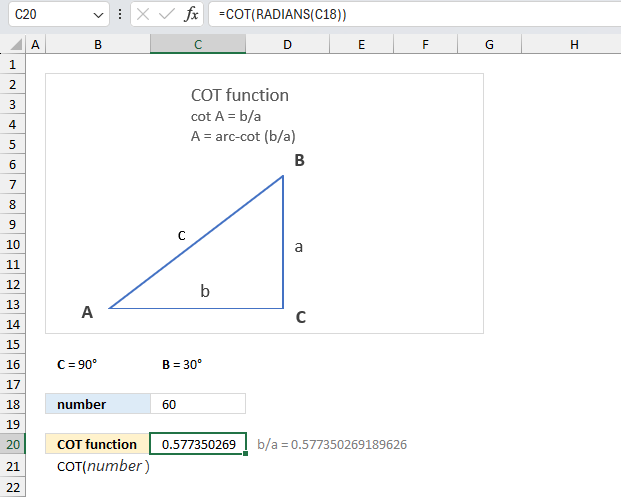
Calculate the cotangent ratio if angle B is 30 degrees?
We know that the sum of the angles in a right-angle triangle is 180 degrees or π radians. 180 = A + B + C
180 = A + 30 + 90
A = 180 - 30 - 90 = 60 degrees
The COT function requires radians in the number argument and we have 60 degrees. The RADIANS function allows us to easily convert the degrees to radians.
Formula in cell C20:
Cell C20 returns 0.577350269189626 which represents the cotangent ratio b/a or the adjacent side divided by the opposite side.
RADIANS(60) converts 60 degrees to 1.0471975511966 radians, the COT function calculates the cotangent ratio based on 1.0471975511966 radians.
7. Function not working

The image above shows the COT function displaying the #VALUE! in cell C3, this is because the input value in cell B3 contains a text string "A". The next error value #NUM! displayed in cell C4 shows up when the input value is equal to or larger than 2^27. The third error value shown in cell C5 appears when the input value is 0 (zero).
For cotangent (cot), the valid input values are:
- All real numbers EXCEPT multiples of π (pi)
- In other words, x ≠ nπ, where n is any integer (0, ±1, ±2, etc.)
This is because cotangent is undefined at x = nπ since it would require division by zero. At these points, the function has vertical asymptotes. The graph of cotangent has a period of π.
For example:
- cot(0°) = undefined
- cot(90°) = 0
- cot(180°) = undefined
- cot(270°) = 0
- cot(360°) = undefined
It might help to remember that cotangent is defined as cos(x)/sin(x), and since sin(nπ) = 0 for any integer n. This leads to division by zero at these points.
7.1 Troubleshooting the error value

When you encounter an error value in a cell a warning symbol appears, displayed in the image above. Press with mouse on it to see a pop-up menu that lets you get more information about the error.
- The first line describes the error if you press with left mouse button on it.
- The second line opens a pane that explains the error in greater detail.
- The third line takes you to the "Evaluate Formula" tool, a dialog box appears allowing you to examine the formula in greater detail.
- This line lets you ignore the error value meaning the warning icon disappears, however, the error is still in the cell.
- The fifth line lets you edit the formula in the Formula bar.
- The sixth line opens the Excel settings so you can adjust the Error Checking Options.
Here are a few of the most common Excel errors you may encounter.
#NULL error - This error occurs most often if you by mistake use a space character in a formula where it shouldn't be. Excel interprets a space character as an intersection operator. If the ranges don't intersect an #NULL error is returned. The #NULL! error occurs when a formula attempts to calculate the intersection of two ranges that do not actually intersect. This can happen when the wrong range operator is used in the formula, or when the intersection operator (represented by a space character) is used between two ranges that do not overlap. To fix this error double check that the ranges referenced in the formula that use the intersection operator actually have cells in common.
#SPILL error - The #SPILL! error occurs only in version Excel 365 and is caused by a dynamic array being to large, meaning there are cells below and/or to the right that are not empty. This prevents the dynamic array formula expanding into new empty cells.
#DIV/0 error - This error happens if you try to divide a number by 0 (zero) or a value that equates to zero which is not possible mathematically.
#VALUE error - The #VALUE error occurs when a formula has a value that is of the wrong data type. Such as text where a number is expected or when dates are evaluated as text.
#REF error - The #REF error happens when a cell reference is invalid. This can happen if a cell is deleted that is referenced by a formula.
#NAME error - The #NAME error happens if you misspelled a function or a named range.
#NUM error - The #NUM error shows up when you try to use invalid numeric values in formulas, like square root of a negative number.
#N/A error - The #N/A error happens when a value is not available for a formula or found in a given cell range, for example in the VLOOKUP or MATCH functions.
#GETTING_DATA error - The #GETTING_DATA error shows while external sources are loading, this can indicate a delay in fetching the data or that the external source is unavailable right now.
7.2 The formula returns an unwanted value

To understand why a formula returns an unexpected value we need to examine the calculations steps in detail. Luckily, Excel has a tool that Here is how to troubleshoot a formula:
- Select the cell containing the formula you want to examine in detail.
- Go to tab “Formulas” on the ribbon.
- Press with left mouse button on "Evaluate Formula" button. A dialog box appears.
The formula appears in a white field inside the dialog box. Underlined expressions are calculations being processed in the next step. The italicized expression is the most recent result. The buttons at the bottom of the dialog box allows you to evaluate the formula in smaller calculations which you control. - Press with left mouse button on the "Evaluate" button located at the bottom of the dialog box to process the underlined expression.
- Repeat pressing the "Evaluate" button until you have seen all calculations step by step. This allows you to examine the formula in greater detail and hopefully find the culprit.
- Press "Close" button to dismiss the dialog box.

There is also another way to debug formulas using the function key F9. F9 is especially useful if you have a hunch that a specific part of the formula is the issue, this makes it faster than the "Evaluate Formula" tool since you don't need to go through all calculations to find the issue..
- Enter Edit mode: Double-press with left mouse button on the cell or press F2 to enter Edit mode for the formula.
- Select part of the formula: Highlight the specific part of the formula you want to evaluate. You can select and evaluate any part of the formula that could work as a standalone formula.
- Press F9: This will calculate and display the result of just that selected portion.
- Evaluate step-by-step: You can select and evaluate different parts of the formula to see intermediate results.
- Check for errors: This allows you to pinpoint which part of a complex formula may be causing an error.
The image above shows cell reference B3 converted to hard-coded value using the F9 key. The hard-coded value is a text value and the COT function expects a number and not a text string. We have found what is wrong with the formula using the F9 key.
Tips!
- View actual values: Selecting a cell reference and pressing F9 will show the actual values in those cells.
- Exit safely: Press Esc to exit Edit mode without changing the formula. Don't press Enter, as that would replace the formula part with the calculated value.
- Full recalculation: Pressing F9 outside of Edit mode will recalculate all formulas in the workbook.
Remember to be careful not to accidentally overwrite parts of your formula when using F9. Always exit with Esc rather than Enter to preserve the original formula. However, if you make a mistake overwriting the formula it is not the end of the world. You can “undo” the action by pressing keyboard shortcut keys CTRL + z or pressing the “Undo” button
Other errors
Floating-point arithmetic may give inaccurate results in Excel - Article
Floating-point errors are usually very small, often beyond the 15th decimal place, and in most cases don't affect calculations significantly.
8. Get Excel *.xlsx file
Functions in 'Math and trigonometry' category
The COT function function is one of 62 functions in the 'Math and trigonometry' category.
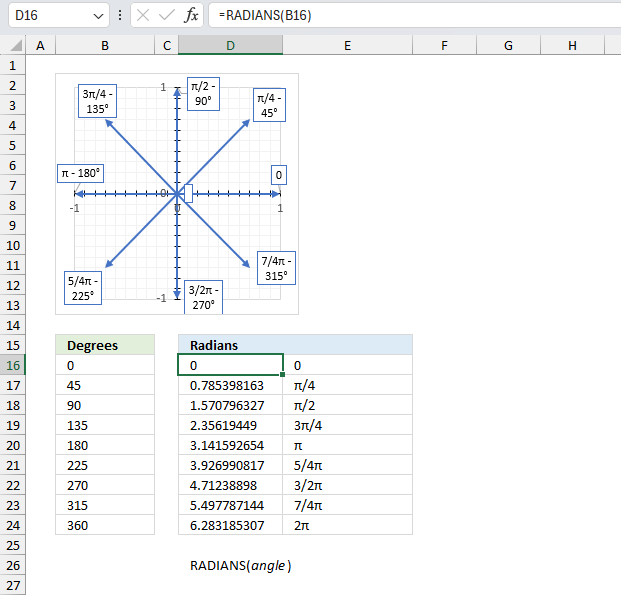
How to comment
How to add a formula to your comment
<code>Insert your formula here.</code>
Convert less than and larger than signs
Use html character entities instead of less than and larger than signs.
< becomes < and > becomes >
How to add VBA code to your comment
[vb 1="vbnet" language=","]
Put your VBA code here.
[/vb]
How to add a picture to your comment:
Upload picture to postimage.org or imgur
Paste image link to your comment.
Contact Oscar
You can contact me through this contact form